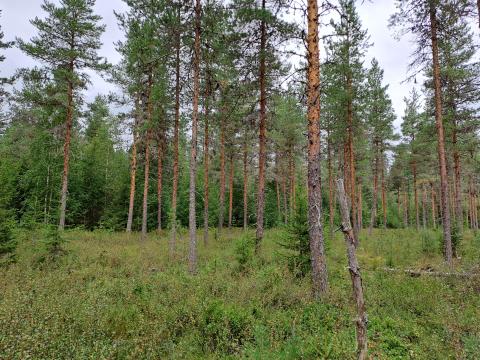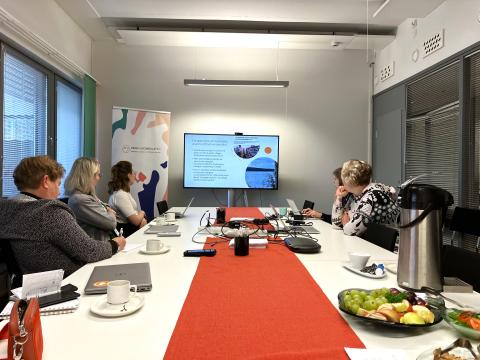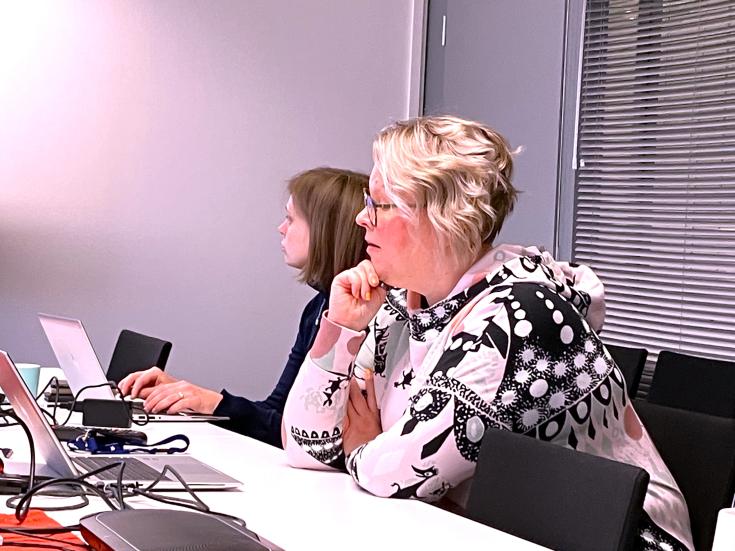Stakeholder meeting in Finland Autumn 2023
Finnish partner arranged their second stakeholder meeting in October 2023. In the meeting we discussed good practices, local specialities in green transition potential and ongoing other projects which interlink with our NACAO.
We had two very interesting presentation linked to our main theme nature-based carbon offsetting, storages and potential natural places. Minna Jaakkola from Sydänsuomessa introduced the transformation of livelihoods in northern parts of Central Finland. Sydänsuomessa is a co-operation network between seven municipalities: Kannonkoski, Karstula, Kinnula, Kivijärvi, Kyyjärvi, Pihtipudas and Viitasaari. Livelihood transformation relates to the peat production, which has been a major industry, especially in Karstula and Kyyjärvi, and will be abandoned. For this reason, the Joint transition Fund will focus on North Central Finland during the coming years.
At the same time the energy transition has been identified as a differentiating factor for the region. Renewable energy projects are planned in all municipalities in the region. The region aims to become a major centre of excellence for renewable energy. Education and vocational training activities are being launched, and consideration is being given to what other new starts could be made, e.g. through new business. What else there could be besides energy production? This is where the NACAO project is seen an entry point.
The Climate Plan project has been launched in the area together with eight municipalities as Saarijärvi joined with others. Work is underway to map the current situation and develop climate plans for municipalities. The project has a major communication role and links to the will to renewable energy production and nature-based carbon offsets.

Helena Reiman from Jamk University of Applied Sciences presented an ongoing project focusing on peatland forests. These areas have been historically mires but between 1950’s to 1970’s many of the mires were drained with ditches. Ditches cause peat decomposition and high CO2 emissions annually. Simultaneously draining and better forest growth has not been achieved. The project Täsmäsuo aims to find new solutions for those former mires, nowadays poorly growing forests, by developing education of their ecology, alternative forest management options, new livelihood options with changed management plans and sustainable use of peatland forests. One objective of the Täsmäsuo project is to reach continuously growth forest management practices to peatland forests which would potentially reduce CO2 emissions from soil.
The discussion after these two presentations was lively. We concluded that it is worth considering the target group for NACAO project activities. It is clear who the actors in the international sector are, but it would be good to think about the Central Finland region, to whom and what is being offered. One key point for local application would be compiling and communicating existing information. That would help local actors and stakeholders to keep up with most recent knowledge and be able to make plans for the future based on that.
At the end of the meeting, we discussed about existing good practices we have. Here some examples:
- Resource-wise Jyväskylä 2040 Programme
- Roadmap for carbon neutrality, Regional Council of Central Finland
- Climate work in city of Äänekoski
- Climate road map ELY-centre
- Finnish Statistical Yearbook of Forestry
- Forest databases for forest owners
- Environmental networks: LuontoKunnat
- HELMI Habitats restoration programme
- Forest Biodiversity Programme for Southern Finland: METSO
- Tools for assessing the climate impact of a land-use plan
- Climate wise urban planning, City of Jyväskylä
More about good practices will be published in our Situational Analysis later in this project.


